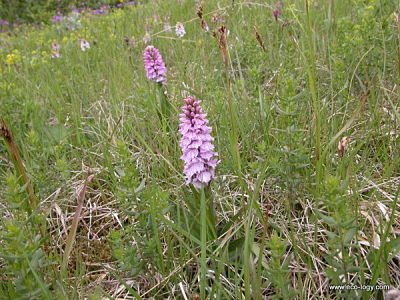BOTANY NEWS
Botanical Information
Welcome to this ninth edition of Botany News!
TOPICS:
1. A note from the editor
2. Northern legumes
3. Delightful ginger
4. Tropical forests - past, present and future
5. A special announcement to Icelandic readers
6. The flower box
Visit our website:
A note from the editor
Greetings and welcome back to Botany News and a special welcome to new subscribers. Summer is here again, bringing sunshine and warmth to Iceland. This issue of Botany News contains topics of interest to readers from around the globe. If you like this ezine/newsletter feel free to recommend it to your friends. All suggestions for improving Botany News are also welcome. Enjoy the rest of the summer and reading Botany News!
Northern legumes
The Vetches (Vicia species) are legumes, with many leaflets and climbing with soft tendrils. Tufted Vetch (Vicia cracca) is a common legume in Iceland as well as all over Europe. This species has small downy leaves, deep purple flowers in large clusters, and forms brown pods later in the season. Tufted Vetch grows on dry terrain, such as sandy soils, grassy slopes and is spreading as a roadside weed in Iceland. A related legume, the Bush Vetch (V. sepium), resembles the Tufted vetch, and boasts red or violet flowers in midsummer and black pods later in the season.
Three species of Peas grow wild in Iceland. These plants are similiar to the Vetches in many respects, while Peas have fewer leaflets and more angled and winged stems. The Meadow Vetchling (Lathyrus pratensis) is rare in Iceland where it thrives on heaths and in forests. However, this species has a wide distribution on three continents, Europe, Asia and Africa. Meadow Vetchling has delicate stems and small clusters of yellow flowers, appearing in July. The black pods form later if the flowers are successfully fertilised by bees. Marsh Pea (L. palustris) has greenish-blue leaves and blue or purple flowers. Additionally, this species seldom flowers and is rare in Iceland. Sea Pea (L. japonicus) as its name incates often grows on sandy banks near the coast, where it is a rapid colonizer of open areas.
A jewel in the flora of Iceland is the low growing Kidney Vetch (Anthyllis vulneraria), its present distribution is mostly limited to two locations in southwestern and northeastern Iceland. This delicate plant has flaming yellow flowers heads. However, you will find this species in city of Reykjavik and the neighbouring towns. Kidney weed is spreading also in the country due to increased protection of land from sheep grazing and along the roads of seaside and fishing communites.
Most legumes are intolerant of grazing, while thriving on protected land where they play a role in improving the soils. White Clover (Trifolium repens) is a common pasture species in Iceland and quite tolerant of grazing, while Red Clover (Trifolium pratense) is rare here. In Iceland native legumes are increasingly used for improving and binding poor soils. An imported plant Nootka Lupine (Lupinus nootkatensis) originating in Alaska is much used for land restoration. Nootka Lupine is spreading rapidly in many parts of Iceland. This species is an effective binder of nitrogen as well as several other nutrients. However, in some parts of the country it is considered a serious weed, overtaking other vegetation and should only be sown in areas where it is unlikely to invade healthy native vegetation.
Delightful ginger
Ginger is the common name for the robust perennial monocot Zingiber officinale. The plant carries fragrant flowers and belongs to the Ginger family (Zingiberaceae). Originating in southern China, Ginger is cultivated throughout tropical and subtropical Asia, especially India. Varieties of Ginger are also grown on other continents, such as Africa and in Neotropical regions of South America. Ginger was brought to Europe by the Romans, and later reintroduced by Marco Polo. The ginger products differ among regions, there are two major varieties, the Jamaician and Indian. Japanese Ginger (Z. mioga) is a related species and is used in salads, as pickles in sushi and an ingredient of tempura dishes.
The gingerroot consumed by man is in fact a knotted, thick, pale rhizome, the rhizomes being the Ginger plants tuberous shoots. Rhizomes are the plant’s primary form of spread, while fruit-eating birds may disperse the seeds. The large, fleshy rhizome, the so called gingerroot contains volatile oils and pungent phenolic compounds. Today, gingerroot is still widely used as a digestive aid, to reduce nausea and occasionally more serious conditions. While fresh Ginger is more refreshing, dried Ginger is sold as a powder and maintains the pungent taste of fresh gingerroot. Fresh Ginger is now available in food stores all over the world and like many other herbs and spices is best consumed fresh. Ginger is a nice addition to many western as well as oriental dishes, and a refreshing tea may be prepared from slices of gingerroot.Tropical forests - past, present and future
The world's tropical forests occur between the Tropics of Cancer and Capricorn, in areas of high temperatures, plenty of sunshine and abundant rainfall. Tropical forests are diverse; typically the forests are dense and layered, with openings for the establishment of woody plants, palms, ferns and occasionally herbs. The giant trunks and strong branches often carry a heavy epiphyte load of orchids and bromeliads. Lianas climb and wind their way up the tree trunk and into the openings in the high canopy. Many tropical plants, such as members of the genus Passiflora, flower in the dry season.
While, nutrient turnover rates are typically high in the forests the soils remain rather nutrient poor. The rainforest food webs are often complex with the rich flora providing an abundance of diverse plant material ranging from nutritious seeds and fruit to juicy nectar and sap sources for countless insects, reptiles, birds and mammals. Currently, this diversity is threatened by man as the forests are much too often cleared on a destructively large scale. This is one of the major reasons why the loss of tropical forests is among the greatest environmental threats facing humanity.
Further readings
Arnthorsdottir, S. 2008. On the growth of lianas in a rainforests. Iceland Forestry, 2: 30-45 (in Icelandic).
A special announcement to Icelandic readers:
- Tilkynning!
Sendið okkur bréf og greinar um gróður til birtingar í næsta hefti Gróðurfrétta (Botany News), þið getið líka skoðað fyrri hefti á netinu.
Mögulegt er að hafa tengla á ykkar vefsíður í blómakassa (flower box) fréttabréfisins eða á tenglasíðunni. Miðlið af ykkar eigin fróðleik til annarra um efni eins og plöntur, gróður, ræktun, náttúru landsins og útivist. Sendið okkur tilkynningar og greinar um fjölbreytt efni tengt náttúruvernd, ferðalögum, garðyrkju, náttúruljósmyndun, umhverfislistaverk o. s. frv. Fyrir þau ykkar sem hafið áhuga á náttúrlegum jurtavörum til gjafa má skoða á sölusíðu Þundar, te og jurtavörur frá Þund henta vel í gjafapakkann! Þetta sumarið er líka tilvalið að fá sér ketil af heitu tei og hafa með sér út í garð! Vinsæla Bláa teið og Yerba mate fást nú aftur eftir nokkurt hlé!
The flower box
Botany News welcomes letters and links from persons working on all aspects of botany, ecology and conservation. Especially, we welcome input from persons working for the environment, biodiversity and conservation around the world. Please, feel free to suggest new links to interesting botanical sites and other green webs for the next Flower Box section.
The summertime is a wonderful time to visit Iceland and explore its amazing nature, where giant cliffs, lava and sands each have their one unique flora and fauna. Why not consider a going on a nature tour such as the Botanical Tours in Iceland? Readers located in Iceland are reminded to check out Thund's sales page for new teas and other natural products.
You can send in your own Botany News articles. Short items on botany, ecology and conservation topics are especially popular. Or send us a review on recent developments in your area of interest and upcoming botanical events.
The articles/announcements need be no longer than 100-300 words. If needed or requested editing can be made of the language. We accept articles in Icelandic, English and Spanish, and will supply the editing requested. However, articles that do fit the profile or purpose of Botany News will not be published. When included your article is still yours and you keep the full copyright.
Submit your Botany News article or announcement!
-----------------------------------------------------------------
Best wishes,
BOTANY NEWS is published by Thund, Reykjavik, Iceland
July 14, 2008 -- Botany News, Issue #009



Fáðu nýjustu fréttir og tilboð frá Þund!
Get updates and special offers from Thund!











